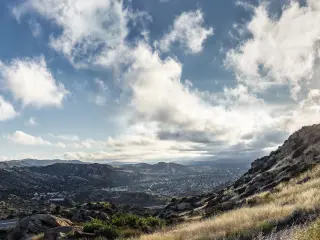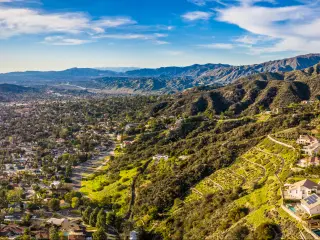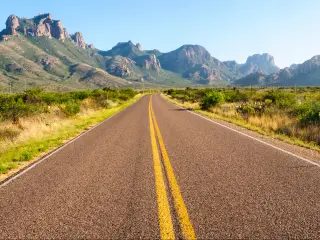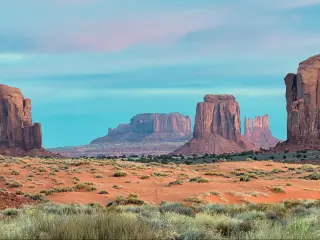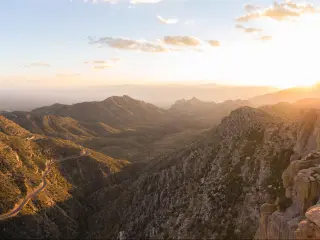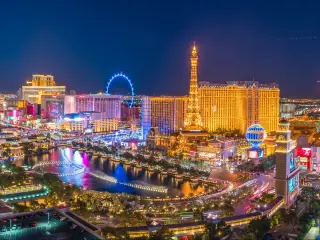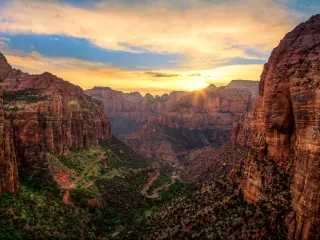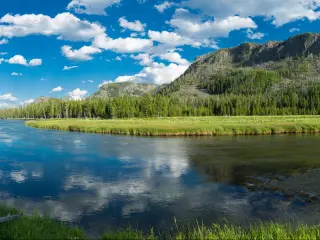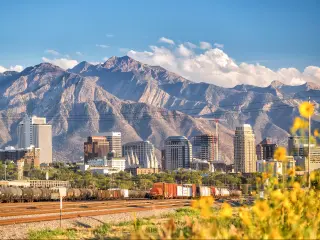Can You Drive Through Zion National Park?
Zion National Park is one of the "Mighty Five", a collection of wondrous National Parks in the state of Utah. Once called Mukuntuweap National Monument, Zion National Park later got its park status alongside a name change to Zion for its utopia-like appearance.
Visitors flock to Utah's Zion National Park to hike through slot canyons, ride the rapids on the Virgin River and enjoy canyon-top views. You can also drive along the breathtaking Zion Canyon Scenic Road, or pick up a shuttle ride in the summer months.
How you enjoy the scenery is up to you, whether it's relaxing and enjoying a picnic or more thrill-seeking activities like mountain climbing the steep cliffs. But before you set off to drive through Zion National Park there are a few things to keep in mind, so carry on reading to get started with planning your trip.
Can you drive through Zion National Park?
Zion National Park sits in the Southwest of Utah. Near the Nevada border, the Springdale entrance is just 160 miles from Las Vegas.
You can drive through Zion National Park along a fabulous scenic drive, which follows Zion Canyon Road. However, depending on the time of year you might have to let someone else take the wheel since private vehicles aren't allowed on the road during the summer.
This helps to avoid overcrowding on the road since Zion National Park is such a popular destination.
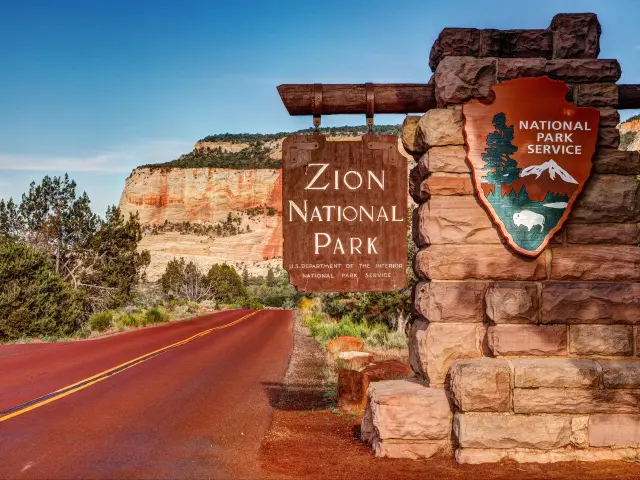
Instead, there's a free shuttle that travels from the South Entrance of Zion National Park up to the Temple of Sinawava. The shuttle is reliable, and frequent, and allows you to sit back and enjoy the scenery, so it's a great way to explore Zion National Park.
The road closure and shuttle running dates vary from year to year, but you should expect to take the shuttle from at least May to November.
The shuttle also runs at the end of December for the holiday season, and at other weekends from fall to spring if the park starts to get busy. When the shuttle is running, you cannot use your own vehicle on this road.
| Route | Starting point | Ending point | Seasonal availability | Time (Distance) |
|---|---|---|---|---|
| Summer Route Private vehicle | Springdale | Temple of Sinawava | 21st May-26th November | 25 minutes (8 miles) |
| Summer Route Shuttle | Springdale | Temple of Sinawava | 21st May-26th November | 45 minutes (8 miles) |
| Winter Route Private vehicle | Mount Carmel Junction | Temple of Sinawava | 27th November-20th May Year-round as far as Canyon Junction | 1 hour (30 miles) |
How to drive through Zion National Park on the Summer Route
As you've already discovered, in summer, you'll have to leave your car at the Zion Canyon Visitor Center Main Parking Lot and jump on the shuttle which will take you along Zion Canyon Scenic Road.
Should you miss a bus, fear not as they run every 5 to 10 minutes. Starting at Zion Canyon Visitor Center, the shuttle then stops at Zion Human History Museum, Canyon Junction, Court of the Patriarchs, Zion Lodge, The Grotto, Weeping Rock and Big Bend before finishing up at the Temple of Sinawava.
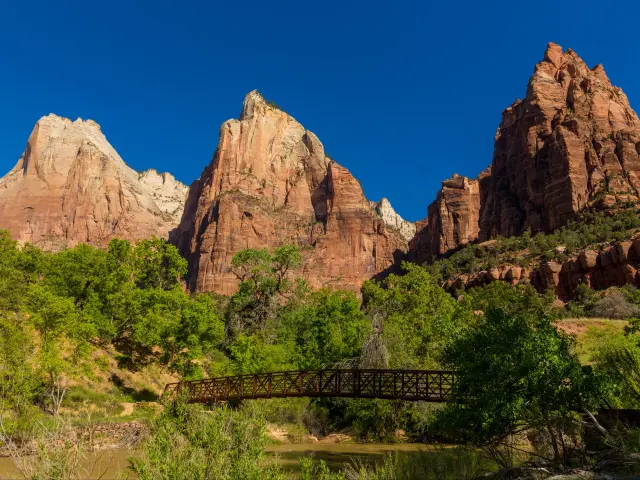
Don't let the fact that you can't drive yourself put you off visiting Zion National Park in summer. The regular shuttle stops make sure you don't miss out on any of the amazing natural landmarks in the park. If anything, the shuttle service allows you to relax and enjoy the view even more!
To see some of the other amazing sights that Zion National Park has to offer, you could hop off the shuttle at Zion Lodge to find the Emerald Pools Trailhead, exit at the Grotto shuttle stop to visit Angels Landing, or hike up to The Narrows from the Temple of Sinawava shuttle stop.
How to drive through Zion National Park on the Winter Route
During the winter months, you can drive Zion Canyon Scenic Road in your own vehicle most of the time. Combine this with the meandering drive in along UT-9 from Mount Carmel Junction and you'll have the ultimate drive-through canyon experience.
It's a mostly straightforward drive along the Winter Route, starting on UT-9 at Mount Carmel Junction then heading west towards Zion. Just after you pass the East Entrance Ranger Station you'll arrive at Checkerboard Mesa View Area before continuing on to Keyhole Canyon and the Many Pools Trailhead.

Before Canyon Junction, expect hair-raising hairpin turns after passing through the Zion-Mount Carmel Tunnel. If you're not a confident driver then this route might not be the best choice.
At Canyon Junction, turn right onto Zion Canyon Road and follow the Virgin River north past Emerald Pools Trailhead, Court of the Patriarchs Viewpoint, Angels Landing and the Temple of Sinawava. Just past the temple, you can pick up the Riverside Walk Trailhead towards the Narrows.
If you're visiting Zion National Park in winter you can also travel around the outside of the park and re-enter via one of the other entrances to enjoy some seasonal activities. You can snowmobile on a section of Kolob Terra Road, which begins in Virgin, Utah.
How long does it take to drive through Zion National Park?
It's a 17-and-a-half-mile round trip to follow Zion Canyon Road from the South Entrance to its northern end at the Temple of Sinawava. This works out at around a 50-minute drive if you self-drive.
If the shuttle is in operation, you might have to wait a little longer for one to arrive, and there will be stops along the way, so allow a little longer to get to the Temple of Sinawava. The shuttle route takes around 45 minutes to travel from the South Entrance Visitor Center up to the Temple of Sinawava.
If you're following the Winter Route, keep in mind that this route is longer as you'll have to get to the East Entrance of Zion National Park first. It's a 30-mile drive to the Temple of Sinawava, which will take at least an hour.
Of course, one of the great things about Zion National Park is that there are some stunning views to enjoy and fabulous trails to follow, so we suggest allowing at least half a day to drive through Zion National Park. Of course, if you want to hike one of the longer trails, you should give yourself a lot longer.
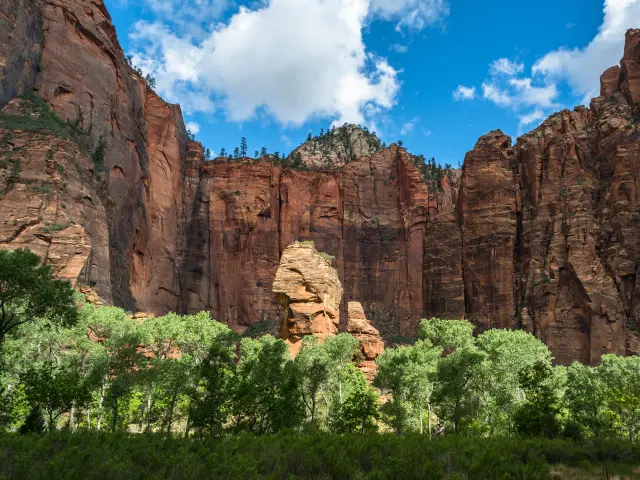
Which entrance should you arrive at in Zion National Park?
The best entrance for a drive through Zion National Park will depend on where you're starting your trip. Most visitors head to the South Entrance in Springdale, which is seen by many as the main gateway to Zion National Park and is easily accessed from I-15 and UT-9.
A popular alternative is Zion's East Entrance, near Mount Carmel Junction. This entrance is also on UT-9. There's a long tunnel between the East Entrance and the Zion Canyon Scenic Drive, so you won't be able to use this route if you're cycling to the national park.
There are two other entrances to Zion National Park, at Kolob Canyons and on Kolob Terrace Road. Kolob Canyons are right in the northwest corner of Zion National Park, and you can't drive through the park from here to see the scenic drive which is the main attraction for most visitors. You also won't reach the Temple of Sinawava from here.
The same goes for the Kolob Terrace Road Entrance. You'll find this on UT-9 before you reach Springfield, but you can't drive through the park from here. However, if you're planning on some serious backcountry hiking, this is a great place to start.
| Origin city | Recommended entrance | Distance | Time |
|---|---|---|---|
| Las Vegas | South Entrance | 160 miles | 2 hours 40 minutes |
| Salt Lake City | East Entrance | 310 miles | 4 hours 35 minutes |
| Phoenix | East Entrance | 380 miles | 6 hours 20 minutes |
| Los Angeles | South Entrance | 430 miles | 6 hours 30 minutes |
| San Diego | South Entrance | 490 miles | 7 hours 30 minutes |
| San Francisco | South Entrance | 730 miles | 10 hours 45 minutes |
| Austin | East Entrance | 1,190 miles | 18 hours 35 minutes |
| Chicago | East Entrance | 1,600 miles | 24 hours |
Best places to stop on a drive through Zion National Park
You drive the entire length of the scenic route through Zion National Park in under an hour if you don't plan on stopping. But you'll miss out on the chance to really soak in the views and follow a hiking trail or two if you're in too much of a hurry.
If you stay a night or two at Zion National Park you'll be able to really immerse yourself in this stunning landscape, as well as having the chance to relax in a pool with a view at the end of the day.
Enjoy the scenery at Springdale
Springdale is known as a gateway to Zion National Park, so it's the obvious choice for many travelers visiting the area. This small settlement also has a lot to offer aside from Zion's stunning views though, from the quaint downtown galleries and access to the Virgin River, which you can tube down in the summer months.
Springdale is less than half a mile from the South Entrance to Zion National Park, so you can drive into the national park in 2-minutes, or walk there in less than 10 to pick up the shuttle bus. This makes it a particularly handy place to stay if you're visiting in the summer.
Book a night at Cliffrose Springdale, Curio Collection By Hilton and you'll be able to park up for free and make use of the shuttle service. This takes away all the hassle of finding a parking space within the national park.
This comfortable hotel has an on-site restaurant which serves breakfast, brunch, lunch and dinner so when you've checked in you'll be well taken care of. There's an outdoor pool and hot tub, spa, fitness center and even yoga classes to enjoy, plus some amazing views.
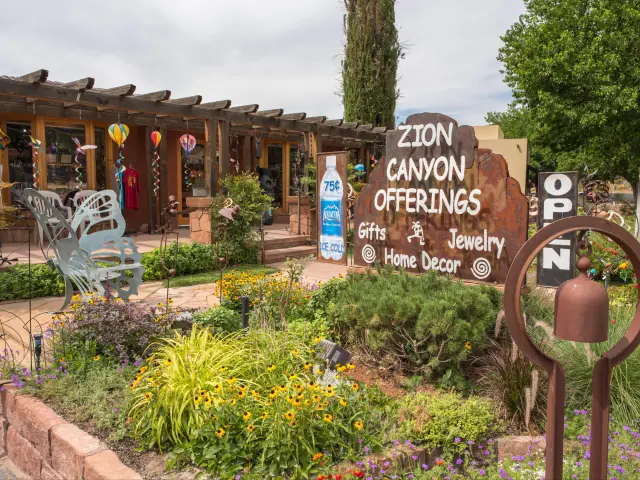
A peaceful stop at Mount Carmel Junction
Mount Carmel Junction is known for being the start of Utah's most famous scenic drive, UT-9. It's a 10-minute drive from the East Entrance of Zion National Park.
It's a great choice if you're visiting in winter, since you can enjoy the scenic drive towards Zion Canyon then continue all the way along Zion Canyon in your own vehicle.
Zion Mountain Ranch is a beautiful property with fantastic views of the mountain meadows. The traditional western ranch interior will give you an authentic experience of Zion, and the hotel even has its own buffalo preserve!
There's free parking at the hotel, and the on-site Cordwood Restaurant serves organic cuisine for breakfast, brunch, lunch and dinner.
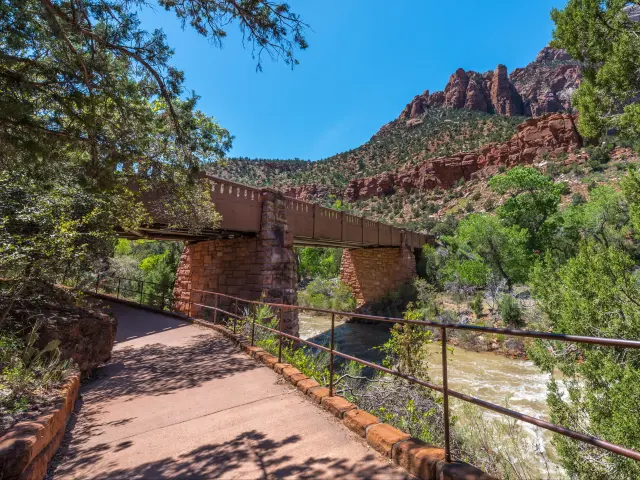
Where to camp in Zion National Park
There are only three campgrounds in Zion National Park so it's best to plan in advance if you're intending to sleep under canvas in the national park.
Watchman Campground is a 5-minute drive from the South Entrance and is open year-round - you can book 6 months in advance so it's a great option for a summer trip if you want to be sure of a space. Its 95 sites have electrical hookups and there's cell phone reception at this campground, so you won't feel too isolated camping out here.
South Campground is also a great place to pitch your tent, but access is currently limited due to drainage work so Watchman Campground is a better option.
If you like the look of South Campground, you'll have a better chance of getting one of the limited spaces here in the winter, and the renovations will be closer to completion too. It's also close to the South Entrance and has flush toilets, drinking water and picnic tables.
At either of these campgrounds you'll be close to three great trailheads, the Watchman Trail, the Archaeology Trail and the Pa'rus Trail, so as well as following the scenic drive you can easily explore part of Zion National Park on foot.
Things you need to know about driving through Zion National Park
Driving through Zion is straightforward; nonetheless, there are a few things you should watch out for.
Perhaps your biggest challenge will be traffic congestion. So pick your times carefully avoiding holidays, weekends and arrive as early as possible.
Zion National Park is a popular destination so it's pretty busy all year round, but during holiday periods or when the kids are on vacation from school car parks fill up before 9am, or even earlier on weekends.
If you find the parking lots inside the South Entrance are already full, you can try to park up in Springdale instead and take the free shuttle to the park. However, allow time to queue for the shuttle if you arrive between 8 AM and noon.
You can visit Zion National Park via UT-9 all year round but as we've already mentioned, Zion Canyon Scenic Road is only self-drive for part of the year. You won't miss out though, since the shuttle takes you along Zion Canyon Road passing through the canyons.
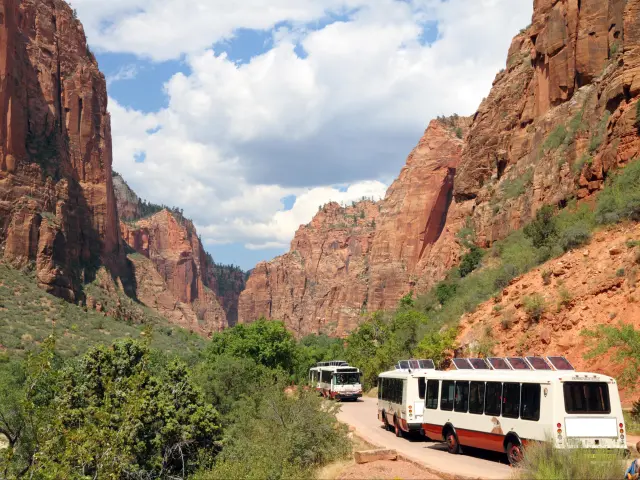
In summer, you'll have to make the drive on the shuttle, plus high humidity and average temperatures in the mid-80s can make this an uncomfortable season, especially if you're planning on hiking.
In contrast, winter is the least busy time to visit unless you're planning a trip during the Holidays or Thanksgiving. The coldest month is December, and even then you can expect an average temperature of 38 degrees Fahrenheit so a visit to the park is manageable if you pack a few warm layers.
We recommend travelling in January if you're hoping for a quiet visit. There are around 90,000 visitors to Zion National Park, compared to half a million in July, and the Zion Canyon Road will be open for you to drive along. Although there are a few days of snowfall through the winter, roads are well-maintained and Zion National Park remains open.
Spring is also a good time to visit. Average temperatures range from 50 degrees in March to 60 degrees in April, and with vibrant greenery and wildflowers blooming, it's a beautiful time of year in Zion National Park. You might also be able to self-drive on a weekday if you're here in early March too. Just be aware that visitors start coming back to the park in their thousands from March onwards.
You can't reserve a ticket at Zion National Park, you just have to roll up and pay at the entrance gate. However, once you're inside the national park you won't have to pay to park or to take the shuttle through Zion Canyon Road
| Ticket type | Adult fare |
|---|---|
| Single adult On foot or bicycle | $20 |
| Private vehicle Up to 15 passengers | $35 |
*Prices calculated at the time of writing for a one-week pass
Here are our other top tips when it comes to preparing for a drive through Zion National Park:
- Check the NPS website to see if you can drive through Zion Canyon on the dates of your visit, or if you'll have to take the shuttle.
- The shuttle will be in operation between 21st May and 26th November, however if Zion National Park gets busy the shuttle will start to operate on weekends as early as February.
- If you arrive late and the queues are long, park at Springdale and get on the shuttle from there.
- Check the last departure times - if the last shuttle is full then you'll have to hike back to the South Entrance from the Temple of Sinawava.
- You'll need to reserve campgrounds, these can sell fast, so book as far in advance as possible. The website allows you to book 6 months ahead.
- If you're entering via the Winter Route from Mount Carmel Junction, bear in mind that there are sharp hairpin turns/switchbacks after the Zion-Mount Carmel Tunnel. Take this section slowly, especially during cold weather.
- Mid to late summer is considered the flash flood season, so check local information to stay safe.
- The Narrows closes during flash floods, so consider this before setting out on the hike.
- For other trail closures, consult the visitor center for the most up to date information.
Things to see on a drive through Zion National Park
Whether you're self-driving or hopping onto a shuttle bus, there are some awesome sights waiting for you when you drive through Zion National Park.
- Zion Canyon Visitor Center: Start your journey at the Visitor Center. It's much more than a gift shop. Here you can fill up on water, find out trail closures and weather conditions while staff can suggest a hike catered to your level.
- Emerald Pools: Hike the paved trail that'll lead you to Lower Emerald Pool and waterfalls. If you fancy going further, the Middle Emerald Pools hike is more challenging while Upper Emerald Pools is the most strenuous.
- Angels Landing: The strenuous 5.4-mile round-trip hike gains 1,488 feet. You'll need a permit to hike to Angels Landing, or, you could go to Scout Lookout, a scenic spot without the knee-trembling heights.
- Court of the Patriarchs: See the three peaks. There's an overlook on Zion Canyon Scenic Drive for views of the sandstone monoliths.
- The Narrows: Hike through narrow sections of Zion Canyon. As you hike through the Virgin River, on either side will be canyon cliffs that in parts reach as high as 2,000 feet and just 30 feet wide.
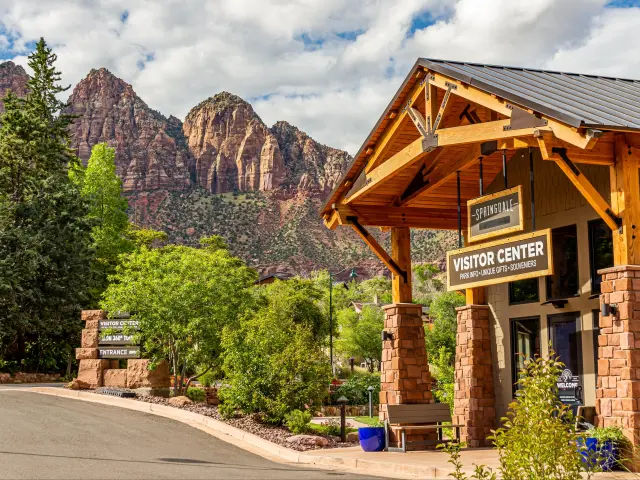
Now all that's left is to lace up your hiking boots, fill up your pack, and decide which of the amazing sights of Zion National Park you'll head to first.

